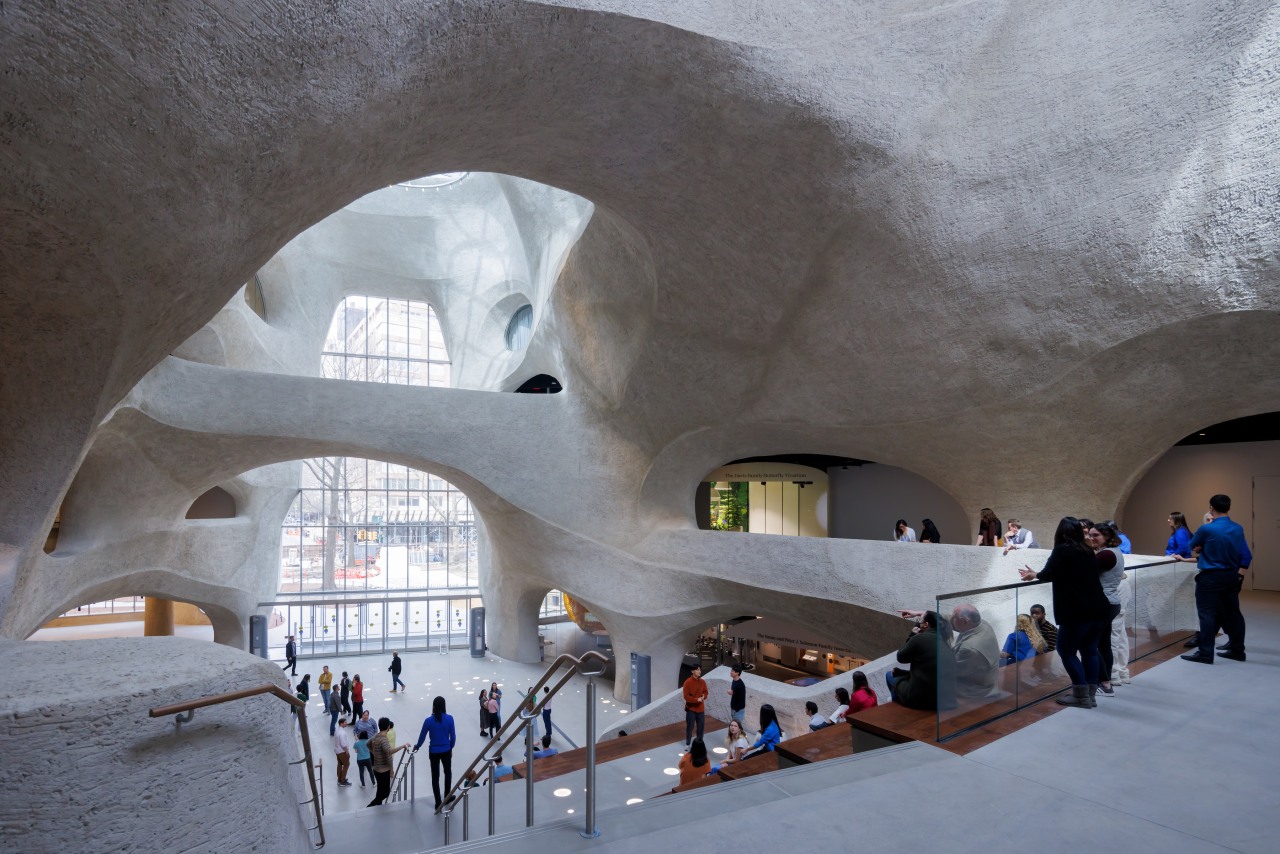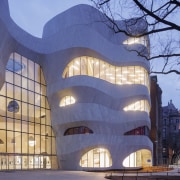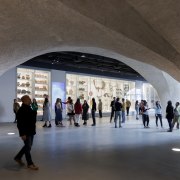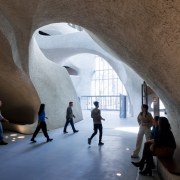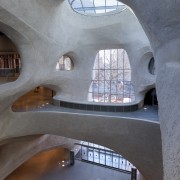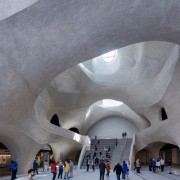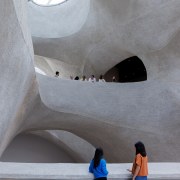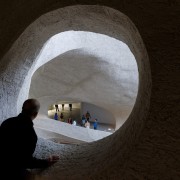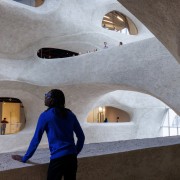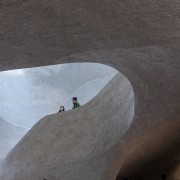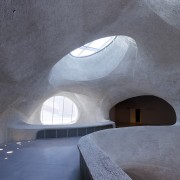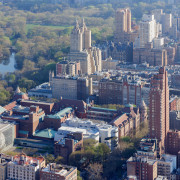Curves, collections and connections
Architectural innovator Studio Gang creates a dynamic new addition to the American Museum of Natural History – the inside-out design creates myriad new exhibit spaces and links existing ones
Designed by Studio Gang
From the architects:
The Richard Gilder Center for Science, Education, and Innovation is the American Museum of Natural History’s most significant addition in over twenty years.
The Gilder Center is designed by Studio Gang, the international architecture and urban design practice led by Jeanne Gang, and is the firm’s largest public project to date.
Studio Gang has emerged as a major architectural innovator over the past decade and Jeanne Gang came to New Zealand recently to speak at an NZIA conference.
The 21,368m² Gilder Center introduces new exhibition, education, collections, and research spaces to the museum, while also bringing essential yet previously back-of-house functions into public view for the first time to give visitors new insight into the full breadth of the Museum’s diverse collections and active scientific research.
Conceived from the inside-out, Studio Gang’s design vastly improves functionality and visitor experience for the entire Museum campus by establishing continuous pathways through its four-block campus, connecting buildings that were constructed over the course of nearly 150 years.
Introducing a new, fully accessible entrance on the Museum’s west side at Columbus Avenue, the project creates a strong east-west axis for the campus and creates more than 30 connections among 10 different buildings that replace former dead ends with continuous loops.
The Gilder Center is designed to invite exploration and discovery that is not only emblematic of science, but also such a big part of being human, says Jeanne Gang, founding principal and partner of Studio Gang.
"It aims to draw everyone in – all ages, backgrounds, and abilities – to share the excitement of learning about the natural world.
“Stepping inside the large day-lit atrium, you are offered glimpses of the different exhibits on multiple levels – you can let your curiosity lead you.
"And with the many new connections that the architecture creates between buildings, the Gilder Center also improves your ability to navigate the Museum’s campus as a whole.”
Natural form-making processes informed the Gilder Center’s architecture.
Akin to a porous geologic formation shaped by the flow of wind and water, the building’s central, five-storey atrium greets arriving visitors like an intriguing landscape, ready to be explored.
Opening the building to natural daylight, the atrium structure also provides intriguing views into different spaces while bridging physical connections between them.
Its structural walls and arches carry the building’s gravity loads.
The Gilder Center is constructed using shotcrete, a technique primarily used for infrastructure, which sprays structural concrete directly onto rebar cages that were digitally modelled and custom-bent.
Eliminating the waste of formwork, the technique achieves a seamless, visually and spatially continuous interior, whose form extends outward to greet the park and neighbourhood beyond.
From the central atrium, visitors can easily find and flow into the surrounding program spaces that embody the Museum’s mission of science and education and connect visitors to the evidence and processes of science.
These new exhibition spaces, designed by Ralph Appelbaum Associates with the Museum’s Exhibition Department, include the Susan and Peter J. Solomon Family Insectarium and Davis Family Butterfly Vivarium that house interactive exhibits with live insects and large-scale, ecological models of their habitats; and the five-storey Louis V. Gerstner, Jr. Collections Core, which houses more than 3 million scientific specimens, three floors of which feature floor-to-ceiling exhibits of scientific collections and provide glimpses into working collections areas.
The Gilder Center also houses Invisible Worlds, an immersive experience that illustrates how all life on Earth is connected; an expanded research library; and state-of-the-art classrooms, learning labs, and education areas that serve students ranging from elementary school through to professional science teachers.
The Gilder Center is a glorious new facility that fulfils a critical need at a critical time: to help visitors to understand the natural world more deeply, to appreciate that all life is interdependent, to trust science, and to be inspired to protect our precious planet and its myriad life forms, says Ellen Futter, President Emerita of the American Museum of Natural History.
“This opening represents a milestone moment for the Museum in its ongoing efforts to improve science literacy while highlighting for our visitors everything the Museum has to offer, and sparking wonder and curiosity.”
Visitors coming from Columbus Avenue experience the Gilder Center as a building set in a park, constructed at the same height as the older Museum buildings that flank it, with flowing, gentle curves.
Offering a visual link between the two sides of the campus, the Gilder Center’s undulating façade, with its inviting expanses of bird-safe fritted glass, is clad in Milford pink granite, the same stone used on the Central Park West entrance.
The diagonal pattern of the stone panels evokes both the phenomenon of geological layering and the design of the richly textured, coursing surface of the masonry on the Museum’s 77th Street side.
Adjacent areas of the park have been enhanced with a new landscape design, developed by Reed Hilderbrand with community input, which features more pathways and seating areas.
Sustainability
Large skylights introduce daylight deep into the building, while the verticality of the Griffin Atrium acts as a key sustainability feature, bringing air circulation deep into its interior.
The HVAC system in the atrium is optimised to provide fresh air to the areas occupied by people – i is highly efficient and leverages the atrium’s uninterrupted height to allow warm air to naturally circulate out of heavily occupied areas.
A high-performance facade with stone cladding, along with deep-set windows and tree shading, will help keep the building naturally cool in summer.
The park’s landscape conserves water by integrating native and adaptive vegetation that requires less water and through a highly water-efficient irrigation system.
The exterior lighting design minimises impact on the night sky.
The Museum is targeting LEED (Leadership in Energy and Environmental Design) Gold certification – a globally recognised symbol of sustainability achievement – by deploying a range of strategies to reduce waste and conserve energy.
Credit list
Project
Executive architect
Structural engineer, acoustical and audio visual consultants
Civil and geotechnical engineer
Signage design
Sustainability
Construction manager
Helpful links
Windows and Doors
Cabinetry Hardware
Spas
Home Builder
Roofing
Heating
Flooring
Taps
Kitchen Design
Home Design
Home kitchen bathroom commercial design
Diving into nature
Classic looks, contemporary efficiency
Personality plus
Commercial Design Trends 40-2C
Keep up to date with what's happening in the commercial office, retail, hospitality, education market sectors and more, ...
Read More